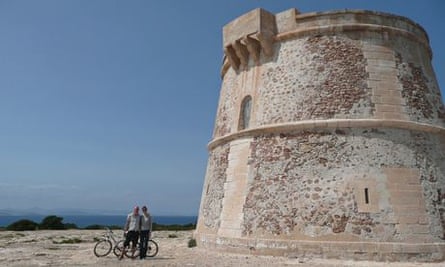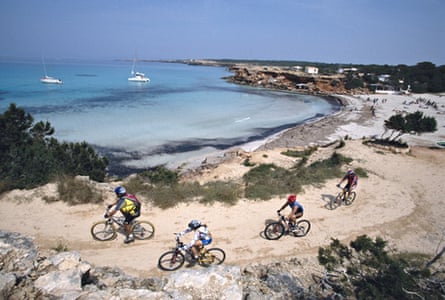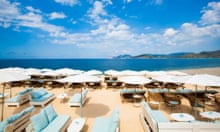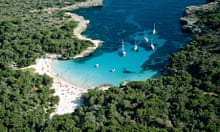'It's the island of the hanged," said the young man standing next to me on the deck of the ferry as we passed a rocky outcrop. I'd spotted the island on my tourist map, but I hadn't understood its name, Isla des Penjats. Now, thanks to my fellow passenger, I sniffed blood. Cloudless sky, turquoise waters, white sand beaches, corpses swinging in the wind - thar be pirates! And there wasn't a swivel-eyed Johnny Depp in sight.
On my hunt for pirates I had come not to the Caribbean, but to the Med, and the short stretch of water between Ibiza and Formentera. From their bases in north Africa, Barbary pirates would sack and pillage – and capture prisoners to sell into slavery. Identifying Isla des Penjats, just off Formentera, confirmed I was on the right track.
It is estimated up to a million Europeans were seized between the 16th and 19th centuries. The pirates' prime targets were in the Med, but they raided as far north as Iceland.
No wonder the people of the Balearics, a tasty target on the pirates' doorstep, were afraid. By the late 14th century, continuous attacks, plus outbreaks of plague, had led to Formentera being abandoned. It was resettled at the end of the 17th century, when four defence towers (plus a fifth on the offshore island of s'Espalmador) were built to keep the pirates away.
Formentera's bloody past is long forgotten – most visitors now come to escape and recover from the excesses of Ibiza. My plan was a bit more ambitious – my girlfriend Carolyn and I would explore Formentera and its pirate past by cycling to each of the towers, handily placed at some of the most beautiful spots on the coast. We should easily do it in a day, I reckoned.
Formentera is about 20km long, so our tower-to-tower route would only be about 30km and the island is pretty flat. But we are spectacularly unfit and only used to occasional comedy wobbles on Boris bikes. The bloke in the bike shop in the island's port, La Savina, looked sceptical at our energetic plans and offered a good deal on a scooter, but off we stubbornly pedalled into the late-morning heat.
Formentera is criss-crossed by Circuitos Verdes, picturesque walking and cycling trails, but unfortunately none led to our first tower, Torre des Garroveret, on the appropriately named Cap de Barbaria, the island's southern tip. There seemed to be a hell of a lot of lorries on the main road south but finally the traffic thinned, the road narrowed and we cycled past pine woods, taking in the smell of the Med in greedy nosefuls.
Simple, single-storey homes behind low dry-stone walls seemed a world away from the bling of Ibiza. A final, sweaty climb had me cursing the scooters that sped by, each carrying a young couple who looked as glamorous as we looked grumpy. But then it was a freewheel downhill to the sparkling sea, a lighthouse, and the tower itself.
It was made of stone and looked solid enough but the tower was little bigger than a bouncy castle. How could it have kept a pack of pirates at bay? A quick google revealed that this was just a watch tower – the soldiers' job was to scan the horizon, raise the alarm if any corsairs were spotted, and then scarper. I couldn't fault the tower's location: it had an amazing view south, to the baddies, and east, to Formentera's biggest stretch of sand, Playa Migjorn, our next target.

Heading north and then east, we got off the main road and joined the Circuitos Verdes network. Asphalt road and gravel tracks took us through countryside until we neared the sea again and our wheels stalled in soft sand. We pushed our bikes to the second tower, Torre des Pi des Català, standing just above Migjorn, a spot blighted to the east by hotel blocks.
Migjorn is also the closest that Formentera comes to Balearic cool. Beach bars and restaurants, such as Gecko Beach Club, Flipper & Chiller and Blue Bar draw celebs and Ibiza refugees. Not looking our best after three hours' cycling, we followed a local's recommendation to Sa Platgeta, a simple beach restaurant, for a fishy lunch, washed down by refreshing wine-based tinto de verano.
Carolyn then snoozed on the beach while I plunged into the sea. I was surrounded by nudists – Migjorn has a fairly relaxed attitude to swimwear – but coyly kept my cossie on.
Somewhat reluctantly, we saddled up and headed north again, stopping briefly in the island's sleepy capital, Sant Francesc, for a drink and a quick look at its church, fortified in the 18th century to make it pirate-proof. An hour later I thought our quest had ended: a giant housing development blocked our path to Torre de Punta Prima. But a quick swerve past a security gate and a nod to the guard had us whizzing past lawns of Stepford Wife perfection and on to the tower, high above the water. This was the most spectacular spot so far. Waves crashed on to the rocks below and superyachts jostled for position in the sheltered waters near La Savina.

We lingered for some selfies in front of the tower but the sun was fading. We found a public path skirting the housing development and then a final set of quiet tracks – we only saw a handful of beach escapees on them all day – took us past windmills and ruins to the far west and the most isolated and atmospheric tower: Torre de la Gavina. Standing there, it wasn't hard to imagine the lives of the soldiers posted here – long days looking out to sea with a mix of boredom and trepidation.
We were done. We had seen the towers that allowed islanders to live in safety, while the pirates turned their attention to less well-defended shores. We felt pleased that we'd summoned up the energy to dig a little under the skin of Formentera. But we were knackered. Perhaps tomorrow we'd be back at these gorgeous spots, sweat-free – on a scooter.
Getting there
EasyJet, Monarch, Ryanair and Norwegian fly to Ibiza from about £70. Ferries to Formentera (30 mins) run frequently from Ibiza Town for about €50 return
How to do it
There are plenty of bike hire places in La Savina. Try rentacarformentera.com on the port, which has bikes from €5 a day
Where to stay
Hostal Rafalet (hostal-rafalet.com, doubles from €65) in Es Caló has basic rooms but a great location. Talaya has bungalows and studios in gardens behind the dunes at Migjorn (talayaformentera.es, studio for two from €140)









Comments (…)
Sign in or create your Guardian account to join the discussion